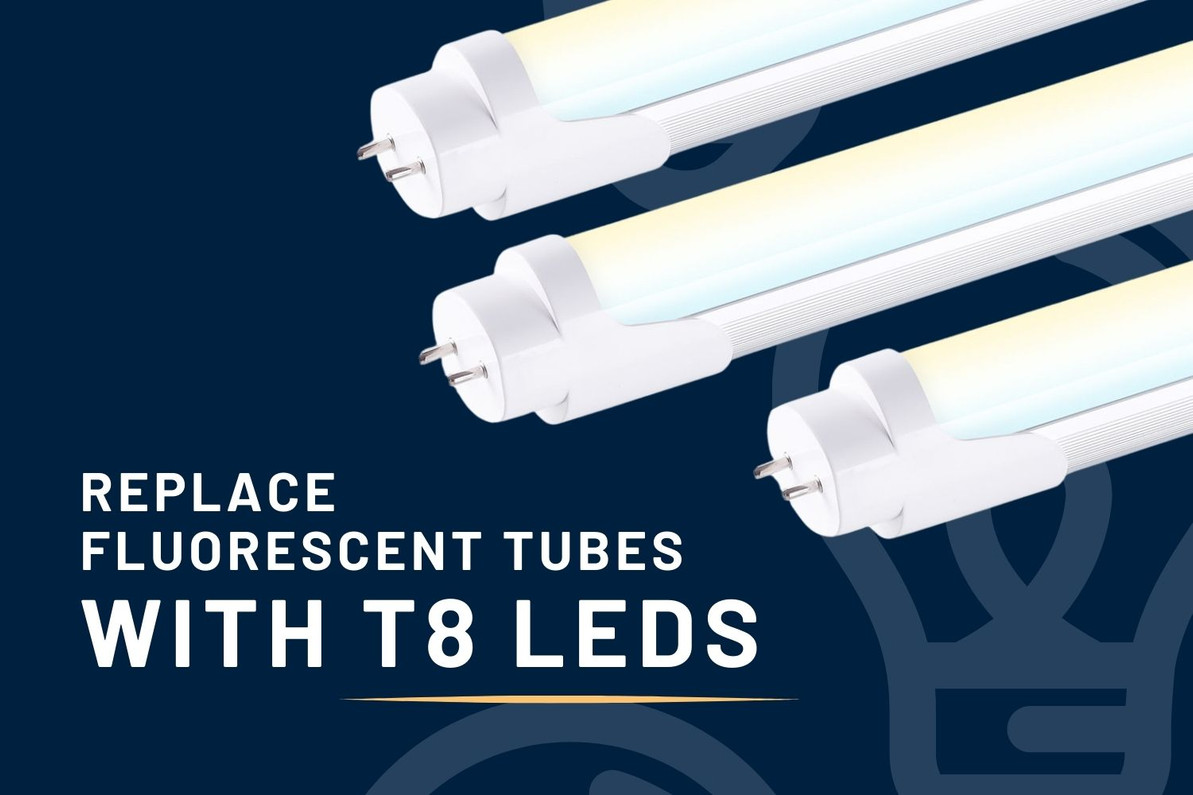Ultimate Guide to Replacing Fluorescent Tubes with T8 LEDs Tubes
Welcome to the ultimate guide that will illuminate your path to a brighter, more energy-efficient future. If you've been grappling with the flickering frustrations and energy inefficiency of traditional fluorescent tubes, it's time to embrace the transformative power of T8 LED technology.
I. Introduction
- Brief overview of fluorescent tubes
- Growing popularity of LED replacements
- Benefits of switching to LED technology
II. Understanding fluorescent tubes
- Explanation of fluorescent tube specifications
- Common issues with traditional fluorescent tubes
- Environmental impact of fluorescent lighting
III. Advantages of Switching to LED
- Energy efficiency and cost savings
- Longevity and reduced maintenance
- Improved lighting quality and color rendering
IV. Step-by-Step Guide to Replacing T8 Tubes with LEDs
- Assessing existing fixtures and compatibility
- Choosing the right LED replacement bulbs
- Installation process and considerations
- Tips for disposal of old fluorescent tubes
V. Troubleshooting and Common Challenges
- Addressing potential compatibility issues
- Dealing with ballast-related concerns
- Ensuring proper wiring for LED retrofit
- Troubleshooting tips for flickering or dimming
VI. Conclusion
VII. Frequently Asked Questions (FAQs)
The table below provides a comparison between the fluorescent tubes and T8 LED Tubes:
| Feature | Fluorescent tubes | T8 LED Tubes |
|---|---|---|
| Energy Efficiency | Moderate | High |
| Lifespan | 20,000 hours | 50,000 hours or more |
| Initial Cost | Moderate | Moderate to High (initially) |
| Operating Cost | Higher | Lower |
| Environmental Impact | Contains Mercury | Mercury-Free, Eco-friendly |
| Color Temperature Options | Limited | Wide Range Available |
| Instant Start | Yes | Yes |
| Dimmability | Limited | Varied (Depends on the model) |
| Retrofitting Options | Limited | Compatible with Many Fixtures |
Introduction
In the ever-evolving landscape of lighting solutions, fluorescent tubes have long been a standard choice. However, as technology advances, the spotlight has shifted to Light Emitting Diodes (LEDs). The shift is not just a trend but a smart and sustainable choice for businesses and homeowners alike.
Brief Overview of Fluorescent Tubes
Fluorescent tubes have been a reliable source of illumination for various applications. Widely used in offices, schools, and industrial settings, these fluorescent tubes have provided decent lighting for years. Yet, with advancements in LED technology, there's a compelling case to bid farewell to the flickers and hums associated with traditional fluorescents.
Growing Popularity of LED Replacements
T8 LEDs have gained immense popularity for several reasons. Not only do they offer improved energy efficiency, but they also boast an impressive lifespan, reducing the need for frequent replacements. As environmental consciousness grows, the shift towards LEDs aligns with the global push for sustainable practices.
Benefits of Switching to LED Technology
The advantages of making the switch are manifold. LED replacements for fluorescent tubes not only consume less energy, contributing to reduced electricity bills, but they also come with a longer lifespan, minimizing maintenance costs. Beyond economics, T8 LEDs provide superior light quality and color rendering, enhancing the overall ambiance of your space.
Understanding fluorescent tubes
Let's unravel the mystery behind fluorescent tubes and why, despite their historical dominance, the need for a transition to LED alternatives is more pressing than ever.
Explanation of Fluorescent Tube Specifications
Fluorescent tubes are a specific type of fluorescent lighting characterized by their 8/8 inch (1 inch) diameter. They operate on the principle of gas discharge, where electricity stimulates the mercury vapor inside the tube, producing ultraviolet light. This, in turn, interacts with the phosphor coating inside, generating visible light.
Despite their efficiency in converting electrical energy into light, The tubes have inherent drawbacks. The gas discharge process is not instant, leading to the familiar flickering and delayed start-up observed in many older fluorescent fixtures.
Common Issues with Traditional Fluorescent Tubes
Flickering and delayed start-ups are not the only challenges associated with the tubes. Over time, these tubes are prone to color shifting, where the emitted light becomes dull or discolored. Moreover, traditional tubes are known for their relatively short lifespan, necessitating frequent replacements and contributing to environmental waste.
Environmental Impact of Fluorescent Lighting
While fluorescent have been a standard choice for their efficiency compared to older fluorescent models, the environmental impact cannot be ignored. The mercury content in these tubes raises concerns about proper disposal, and the energy consumption, although lower than older technologies, still falls short of the efficiency.
Energy Efficiency and Cost Savings
One of the standout features of T8 LED Tubes is their remarkable energy efficiency. LEDs convert a higher percentage of electrical energy into visible light compared to traditional fluorescents. This translates into substantial energy savings, positively impacting your electricity bills. According to the U.S. Department of Energy, LEDs use up to 80% less energy than traditional lighting sources.
And the savings don't stop there. The long lifespan of LEDs means fewer replacements, reducing maintenance costs and the overall environmental footprint. With LED tubes, you'll not only brighten your space but also lighten the load on your wallet.
Longevity and Reduced Maintenance
Say goodbye to the hassle of frequent tube replacements. T8 LED tubes boast an impressive lifespan, often surpassing that of traditional fluorescent tubes by several years. The extended durability of LEDs means less downtime, lower replacement costs, and a more sustainable lighting solution.
According to a study by the American Council for an Energy-Efficient Economy (ACEEE), LEDs have an average lifespan of 25,000 to 50,000 hours, compared to the 7,000 to 15,000 hours of traditional fluorescent tubes. This longevity not only reduces the frequency of replacements but also contributes to a significant decrease in overall waste.
Improved Lighting Quality and Color Rendering
Beyond efficiency and lifespan, LEDs offer superior lighting quality and color rendering. Traditional fluorescents often struggle with color consistency and accuracy, leading to a less visually appealing environment. LEDs, on the other hand, come in a variety of color temperatures, allowing you to customize the ambiance of your space.
The Color Rendering Index (CRI) measures the ability of a light source to accurately represent colors. LEDs typically have a higher CRI than fluorescents, ensuring that colors appear more natural and vibrant. Enhance the visual appeal of your surroundings with LED technology that not only brightens but also enhances the true colors of your space.
Assessing Existing Fixtures and Compatibility
Before making the switch, take a closer look at your existing fixtures. Ensure they are in good condition and compatible with LED tubes. Check for any signs of wear, and if needed, consider minor repairs or modifications. Compatibility is crucial for a trouble-free transition.
According to lighting experts at LEDLightGuides, understanding the compatibility of your fixtures and ballast is key. Some fixtures may require a ballast bypass, while others can accommodate direct replacement LED tubes without any modifications.
Choosing the Right LED Replacement Bulbs
Not all LED tubes are created equal. To reap the maximum benefits, choose LED replacement that align with your specific needs. Consider factors such as color temperature, brightness, and potential energy savings. Look for tubes with a high lumens output for optimal illumination.
The Department of Energy suggests selecting LED tubes with the ENERGY STAR label for enhanced energy efficiency. This label ensures that the product meets strict performance and efficiency standards, providing assurance of quality and savings.
Installation Process and Considerations
Once you have the compatible fixtures and the right LED replacement bulbs Begin by turning off the power to the existing fixtures to ensure safety during the replacement. Follow the manufacturer's guidelines for installation, which typically involve straightforward steps like removing the old tubes and inserting the new LED tubes.
Tips for Disposal of Old Fluorescent Tubes
Proper disposal of old fluorescent tubes is a critical aspect of the transition to LED technology. Due to the mercury content in traditional tubes, they should not be disposed of in regular waste bins. Explore recycling options in your local area or take advantage of specialized recycling programs.
The Environmental Protection Agency (EPA) provides guidance on recycling compact fluorescent lamps (CFLs), which share similarities with fluorescent tubes in terms of mercury content. Local recycling facilities or retailers may also offer collection services for proper disposal.
Troubleshooting and Common Challenges
As you embark on the exciting journey of transitioning to LED lighting, it's essential to be prepared for potential challenges. Addressing these issues proactively will ensure a smooth and trouble-free experience.
Addressing Potential Compatibility Issues
While LED technology is versatile, compatibility issues may arise when retrofitting existing fixtures. Some older fixtures may not be optimally designed for LED tubes, leading to flickering or compatibility problems. In such cases, consider consulting with a lighting professional to explore compatibility solutions or fixture upgrades.
Understanding the specific requirements of your fixtures and consulting with experts can help mitigate compatibility challenges.
Dealing with Ballast-Related Concerns
The role of the ballast in traditional fluorescent fixtures can become a point of concern when transitioning to LED tubes. Some LED tubes require the removal or bypass of the ballast, while others are compatible with existing ballasts. Refer to the manufacturer's guidelines and, if necessary, seek professional assistance to ensure the correct handling of ballast-related considerations.
Guidance from EnergyStar emphasizes the importance of choosing ballast-compatible LED tubes and provides valuable insights into the installation process.
Ensuring Proper Wiring for T8 LED Retrofit
Correct wiring is crucial for the successful retrofit of T8 LEDs. Incorrect wiring can lead to issues such as flickering, uneven illumination, or even damage to the LED tubes. Follow the wiring instructions provided by the LED tube manufacturer diligently, and if in doubt, seek the expertise of a qualified electrician.
For a comprehensive understanding of proper wiring techniques, refer to EnergyGov, which outlines step-by-step procedures to ensure a secure and efficient LED retrofit.
Troubleshooting Tips for Flickering or Dimming
Flickering or dimming of LED tubes can be an unsettling experience. Fortunately, troubleshooting these issues often involves simple solutions. Check for loose connections, ensure proper wiring, and confirm compatibility with existing fixtures. If problems persist, consider consulting with a professional to identify and address the root cause.
The LampShopOnline provides insights into troubleshooting common LED tube issues, offering valuable tips to enhance the performance and longevity of your LED lighting system.
Conclusion
Now, as you stand on the cusp of making this transformative change, consider the lasting impact your choice can have. LED technology not only brightens your immediate surroundings but also contributes to a global shift towards energy efficiency and sustainability.
Frequently Asked Questions (FAQs)
Here are answers to frequently asked questions that will further guide you in making a well-informed decision:
- Can I use my existing fixtures for LED replacement?
- Yes, in many cases, existing fixtures can be used for LED replacement. However, it's crucial to assess compatibility. Some fixtures may require modifications or ballast bypass, while others can accommodate direct replacement LED tubes.
- Yes, in many cases, existing fixtures can be used for LED replacement. However, it's crucial to assess compatibility. Some fixtures may require modifications or ballast bypass, while others can accommodate direct replacement LED tubes.
- Are there any rebates or incentives for switching to LED?
- Yes, many utility companies and government programs offer rebates or incentives for transitioning to energy-efficient lighting, including LED technology. Check with your local utility provider or visit the Database of State Incentives for Renewables & Efficiency (DSIRE) for information on available incentives in your area.
- Yes, many utility companies and government programs offer rebates or incentives for transitioning to energy-efficient lighting, including LED technology. Check with your local utility provider or visit the Database of State Incentives for Renewables & Efficiency (DSIRE) for information on available incentives in your area.
- What color temperature is suitable for my space?
- The ideal color temperature depends on the specific ambiance you want to create. Warmer temperatures (2700K-3000K) mimic traditional incandescent lighting and are suitable for a cozy atmosphere, while cooler temperatures (4000K-5000K) provide a brighter, more daylight-like illumination. Consider the function and mood of your space when choosing color temperatures.
- The ideal color temperature depends on the specific ambiance you want to create. Warmer temperatures (2700K-3000K) mimic traditional incandescent lighting and are suitable for a cozy atmosphere, while cooler temperatures (4000K-5000K) provide a brighter, more daylight-like illumination. Consider the function and mood of your space when choosing color temperatures.
- Do I need an electrician for the retrofit process?
- The complexity of the retrofit process varies. While some installations are straightforward and can be done by DIY enthusiasts, others may require the expertise of a qualified electrician. If you're unsure about the wiring or encounter any challenges, it's advisable to seek professional assistance to ensure a safe and efficient retrofit.
- The complexity of the retrofit process varies. While some installations are straightforward and can be done by DIY enthusiasts, others may require the expertise of a qualified electrician. If you're unsure about the wiring or encounter any challenges, it's advisable to seek professional assistance to ensure a safe and efficient retrofit.
- How do LED replacements contribute to environmental sustainability?
- LED replacements for T8 tubes contribute to environmental sustainability in several ways. They consume less energy, leading to reduced greenhouse gas emissions. Additionally, their longer lifespan minimizes the frequency of replacements, resulting in less overall waste. Proper disposal of old fluorescent tubes further ensures that environmental impact is minimized.
- LED replacements for T8 tubes contribute to environmental sustainability in several ways. They consume less energy, leading to reduced greenhouse gas emissions. Additionally, their longer lifespan minimizes the frequency of replacements, resulting in less overall waste. Proper disposal of old fluorescent tubes further ensures that environmental impact is minimized.
Feel free to refer back to this comprehensive guide for further insights into these FAQs and additional details on making the transition to LED lighting. Illuminate your path with knowledge and make the most informed choices for a brighter and sustainable future!
Recent Posts
-
Global Turmoil and its Impact on Ocean Shipping Rates: Challenges for the Lighting Import Industry
Introduction: Amidst ongoing global conflicts such as the Israel-Palestine issue and the Russia-Uk …28th Feb 2024 -
Lighting Imports: Adapting to Global Shipping Challenges
In the current landscape of global upheavals and their consequential impact on ocean shipping rates, …28th Feb 2024 -
Ultimate Guide to Replacing Fluorescent Tubes with T8 LEDs Tubes
Welcome to the ultimate guide that will illuminate your path to a brighter, more energy-efficient …16th Jan 2024





